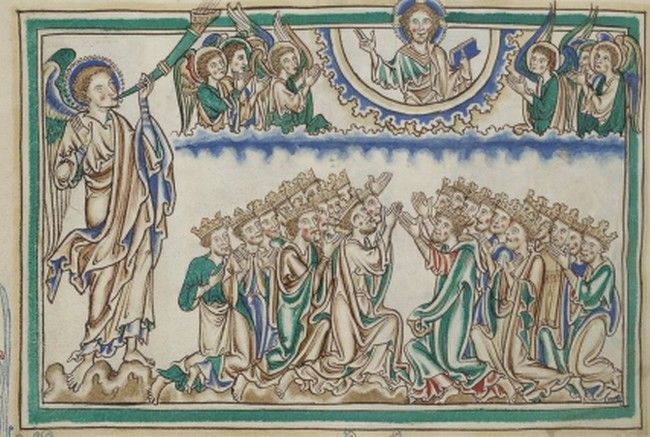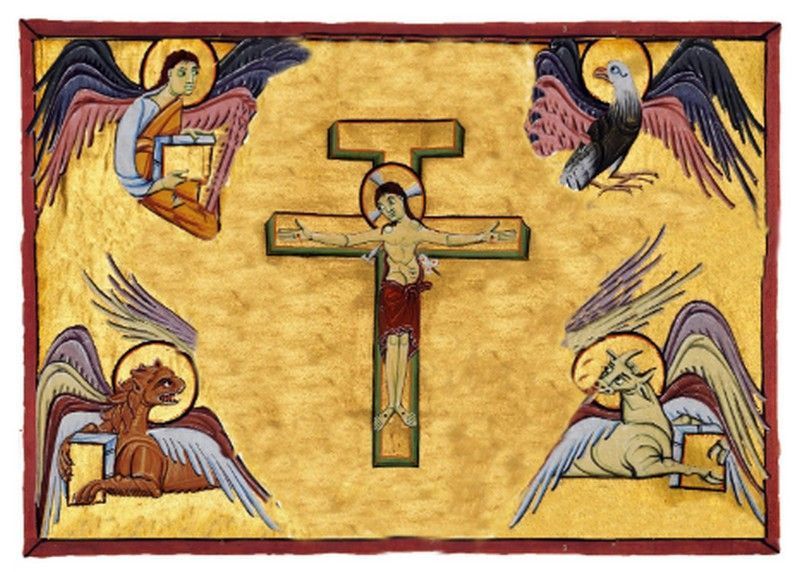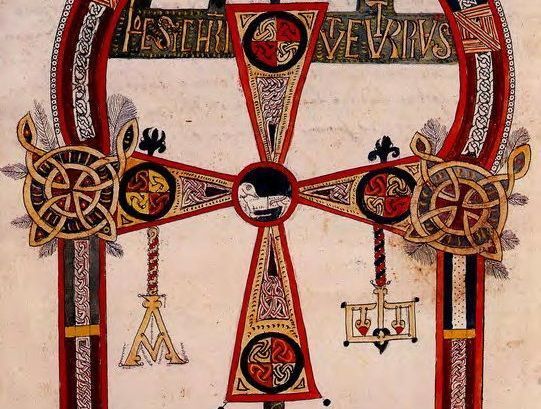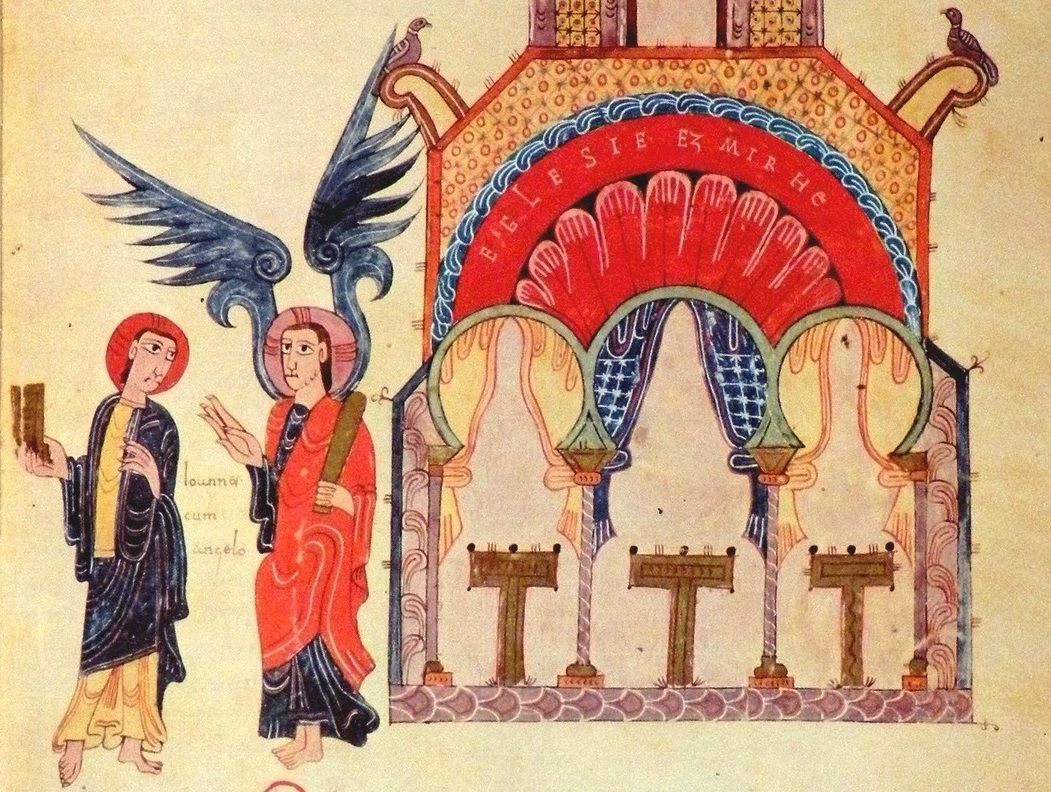General description of the manuscripts
ANTIFONARIO DE LEÓN
San Cipriano del Condado - 915? - Catedral de León
It is the most complete and best preserved Latin antiphonary from the Middle Ages. It was created by the end of the 9th or beginnings of the 10th centuries. It contains the most important chants of the Spanish liturgy until the end of the 11th century. It is written in Visigothic italics with neumes without stave, using the Visigothic notation and includes an interesting set of images in very defined colours, always on uncoloured background, of high quality considering its ancient dating.
APOCALIPSIS DE AVIANUS
North of France - Between 890 and 910 - National Library, Paris
Manuscript dated to the beginning of the 10th century that includes two very distinct parts. The first is a copy of the Apocalypse of Valenciennes in which all the miniatures are imitated although with a different style and in this case they are not full-page but are interspersed without borders in the texts. The second part is made up of ten illuminated animal fables, written by Avianus in the fourth century, of which another 32 have been lost. Its origin is some monastery in the North of France but with a treatment of the images very different from the rest of codices of that time in the area.
APOCALIPSIS DE CAMBRAI
Cambrai - 900 - Médiathèque municipale de Cambray.
Dated around the year 900, by its size we can assume that it was dedicated for public use in some church of Cambrai, from which it must have passed to the cathedral library and from this to its current situation.
It is one of the oldest European Apocalypses and at the same time one of the most beautiful and best preserved of its time. With 46 full-page miniature texts framed on the page opposite the corresponding image, it contains complex scenes, of great color, which has maintained its luminosity for more than 1,100 years.
APOCALIPSIS DE ISABEL DE FRANCIA
Paris, Court of Philip IV - 1313 - Bibliotheque National, París.
Manuscript commissioned by Philip the Fair, King of France, for his daughter Elizabeth, Queen of England. It was completed in 1313 by the miniaturist Colín Chadelves. With its 162 large, high-quality miniatures, most of them full-page, which form one of the longest picture cycles of the Apocalypse, to which is added a very complete text translated into French from an earlier Latin, to which are added 78 folios of commentaries also in French, which do not include images, is one of the most interesting illuminated manuscripts of the first quarter of the fourteenth century.
APOCALIPSIS DE PARIS
England - 13th century. - National Library of France, París
Of English origin, dated around 1250, he is one of the oldest representatives of the Gothic version of the Illustrated Apocalypse. In its preparation different models were used for the text and for the 90 images of half page, framed, which includes. In addition to the biblical text, it includes in the first and last pages the life of Saint John. It is considered one of the 58 Apocalypses of which are considered as the result of the commission of a particular individual.
APOCALIPSIS DE TREVERIS
Monastery in the west of the Carolingian Empire - 810 - Saint Eucharius Monastery in Trier.
This is the oldest surviving version. Created between the years 800 and 820, in the middle of the Carolingian period, possibly in a monastery located in the west of the Carolingian Empire, in the vicinity of the Abbey of Saint-Martin de Tours. With a usual structure in the Carolingian minature, with the text on the full page in front of the image on the opposite page. While the text seems to come from an Ialian Vlgate, the cycle of images possibly comes from Late Antiquity.
APOCALIPSIS DE VAL-DIEU
Normandy - 1320-1330 - The British Library, London
It is the first of the group of four copies of the Apocalypse of Saint John produced in Normandy throughout the 14th century, which in this case also includes Berengaudo’s commentary and is the only case in which the Latin version is added to another in French. Of the four it is the one that best preserves the aesthetics of the Romanesque in miniatures of great quality, with a refined technique and a perfect combination of colors, all of half-page framed.
APOCALIPSIS DE VALENCIENNES
Monastery of Central Rhine - 9th Century - Municipal Library of Valenciennes.
To our French friend Jean-Luc Monneret who has sent us his work on this manuscript. which we recommend, from which we have obtained all the images in our file.
APOCALIPSIS Y VIDA DE SAN JUAN Ms 38121
Netherlands, S. - 1400 - The British Library, Londres
Manuscript created in the Netherlands around 1400, within the tradition of the English Apocalypses of the thirteenth century, which includes in addition to the Apocalypse images of the life of St.John, It consists of 47 folios of parchment with 90 half-page miniatures and another four full-page, colourful and decorated with gold, located in the verse of the folios, while the text, which only always occupies the verse up to folio 22, leaving the others blank
BAMGBER APOCALYPSE
Benedictine monastery of Reichenau - 1000-1020 - Staatlichen Bibliothek de Bamberg
It is the only illuminated Apocalypse of Ottonian style that has reached us, and with its 57 framed miniatures, most of full page, of great expressive power illuminated with high quality colors and gold backgrounds, and its up to 103 capital letters, All decorated with gold, the Bamberg Apocalypse, is considered the most important manuscript of those preserved in the Bamgber State Library.
BEATO CORSINI
Monastery of Sahagún? - Principios del S. XII - Biblioteca Corsiniana, Roma
Manuscript of Spanish origin, probably from the monastery of St. Benedict of Sahagún, that stands out from the rest of blessed for its reduced size and for including just eight miniatures. Nothing is known about its history nor how it became a Corsini family belonging although it is possible it passed by the hands of the Count Duke of Olivares, who requisitioned many codex from churches and monasteries.
BEATO DE SAN MILLÁN
San Millán de la Cogolla - Siglos X y XI - Real Academia del la Historia, Madrid
Illuminated in two phases, one clearly Mozarabic, from the end of the 10th century, considered as the most typical work from St. Millán de la Cogolla’s scriptorium, and the other one with very different characteristics, possibly from the end of the 11th century, where the spaces left by the scribe were filled with new miniatures. In the paintings of this phase, sometimes intermingled with the former one, there are lots of characteristics of clear Romanesque influence.
Beato de Berlín
Central Italy - Principles of S. XII - Statatsbibliothec Preussischer Khulturbesitz, Berlín
It is another blessed created out of Spain. With 98 pages of 300 x 190 mm written in Caroline typeface, although in the text of the drawings the Visigothic typsetting is used, and its 55 pen and ink drawings in small size looks very different than the rest of the known blessed. It is attributed to some monastery in the centre or south of Italy and John Williams includes it in the same group of the Blessed of Burgo de Osma and Lorvao, although the carachteristics of their miniatures are quite different.
BEATO DE BURGO DE OSMA
Monastery of Sahagun - 1086 - Cathedral of Burgo de Osma (Soria)
Developed during the full Cluniacense influence, this blessed, that consists of 166 pages and 71 miniatures, although maintaining clear influences of Mozarabic works like the first blessed of the National Library, the one of El Escorial and the one of St. Millán, has a clear link with the Romanesque painting, for instance, in the
replacement in some cases of the horseshoe arches by semi circular ones, or in the apparel of the characters that clearly reflect the customs in the 11th century. We can consider it as the first Hispanic Romanesque blessed.
Beato de Ciruena
Monastery of the Navarre Pyrenees? - IXe siècle. -
Only one page of this manuscript has been preserved coming from St. Andrew of Cirueña, who was protecting a document from 1074. Both for its archaic caligraphy as well as for the poor quality of the colours of the miniature and of the signing ink, it is considered as the most ancient Blessed of which a segment has reached these days, possibly created around the year 900 or even earlier, in a scriptorium in the Pyrenees, as it contains some abbreviations more common in France than in the Mozarabic manuscripts of Castile and León.
BEATO DE EL ESCORIAL
St. Millán de la Cogolla - 955 - El Escorial Monastery
Considered almost unanimously as have been originated in St. Millán de la Cogolla and dated between 950 and 955. It consists of 151 pages and 52 miniatures that show the characteristics of the works of said monastery: aggressive colours with yellow predominating as a background; characters’ faces treated equally, with great expression, almond eyed, straight necks, lip corners downwards and double lobed ears.
Beato de Fanlo
San Millán de la Cogolla - 1040/1060 - Copies i B. Morgan, N. York
From this manuscript only seven pages have been preserved. Copied in the 17th century, they reproduce in water colour those of a volume of the blessed disappeared, that for its similarity it seems to belong to the same family than the Blessed of St. Millán de la Cogolla preserved in the Monastery of El Escorial. It was possibly donated to the abbot Banzo from the Monastery of Fanlo, in the Pyrenees of Aragón, thanks to Ramiro the First -the monarch of Aragon-‘s mediation, to whom the manuscript is dedicated as shown in its colophon.
BEATO DE FERNANDO I
León - 1047 - Biblioteca Nacional (Madrid) Vitr. 14-2
This is the only blessed (with the possible exception of the Blessed of Las Huelgas) that was copied for the kings of Castile and León. Commisioned by Ferdinand the First and Doña Sancha, it consists of 624 pages of 360 x 268 mm to 2 columns in Visigothic writing and 98 miniatures of great quality. It was preserved in the Colegiata of St. Isidore of León until Philip the Fourth requisitioned it and sent it to the Royal Library. Today it is preserved in the National Library of Madrid, in the showcase 14,2. Illustrated during the period in which the Cluniacense influence was beginning to show up, it corresponds to a very meaningful change in style with regard to the Spanish miniature of the preceeding century.
BEATO DE GERONA
San Salvador de Tábara - 975 - Cathedral of Gerona
With 568 pages in two columns and 114 miniatures, it is the blessed with the most number of illustrations ever preserved, including an important amount of illustrative material not available in previous blessed. Main authorship attributed to the nun Ende, it is the only blessed which illumination had been carried out by a woman, what seems to be reflected through its exuberant polichromy, in the vigour of its shapes and in the iconographic innovations not found in the rest if the blessed.
BEATO DE GINEBRA
Abbey of Monte Cassino? - Mediados del siglo XI - Biblioteca de Ginebra
Blessed recently discovered when the Missionaries of La Salle deposited a collection of old manuscripts in the Library of Geneva. Written in round Caroline typeface and the largest part in Beneventana typsetting. Although this type of letter indicates an Italian origin, its miniatures respect the structure and contents of the Spanish blessed, although the style has little relationship with the Mozarabic miniature.






















